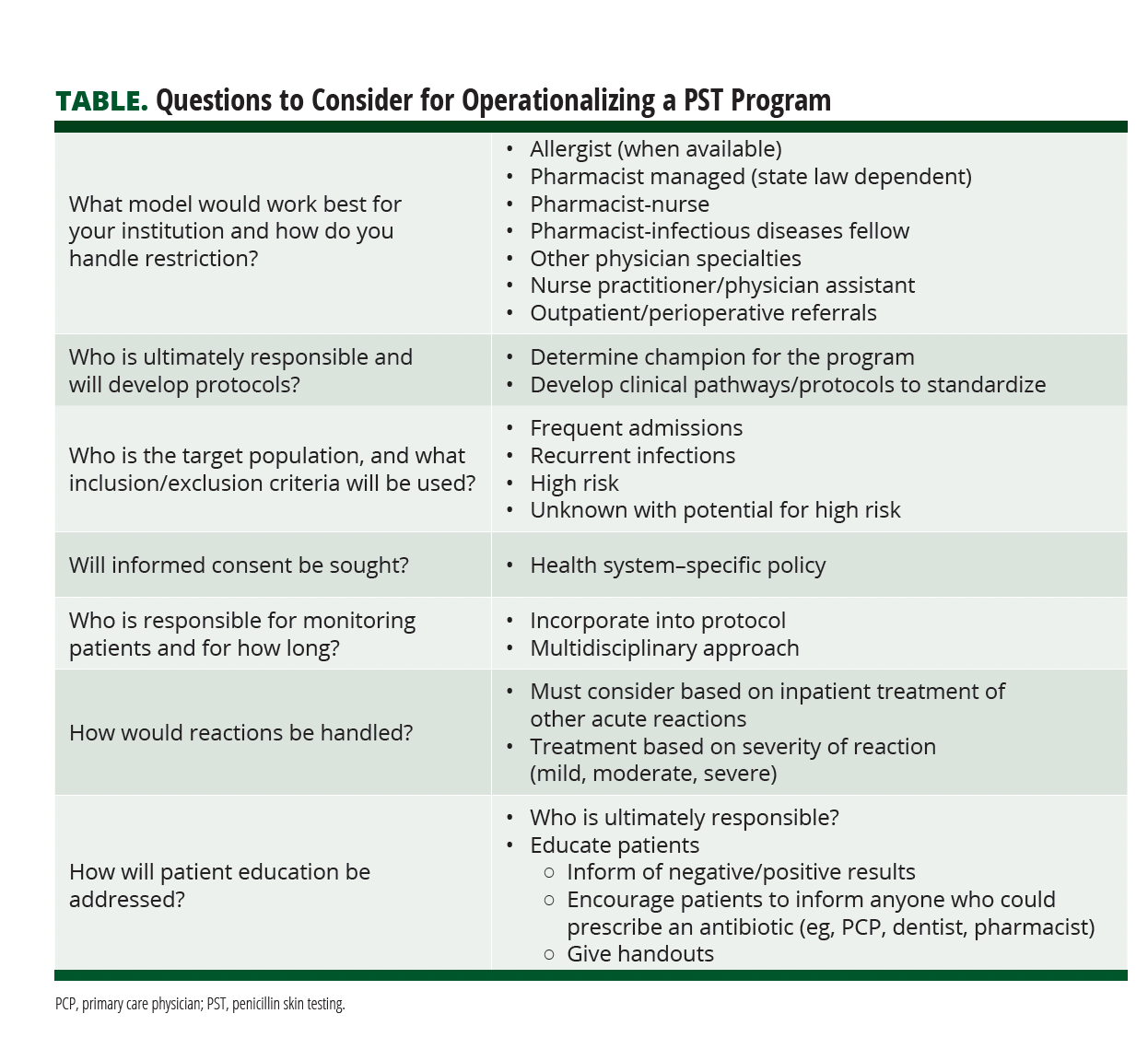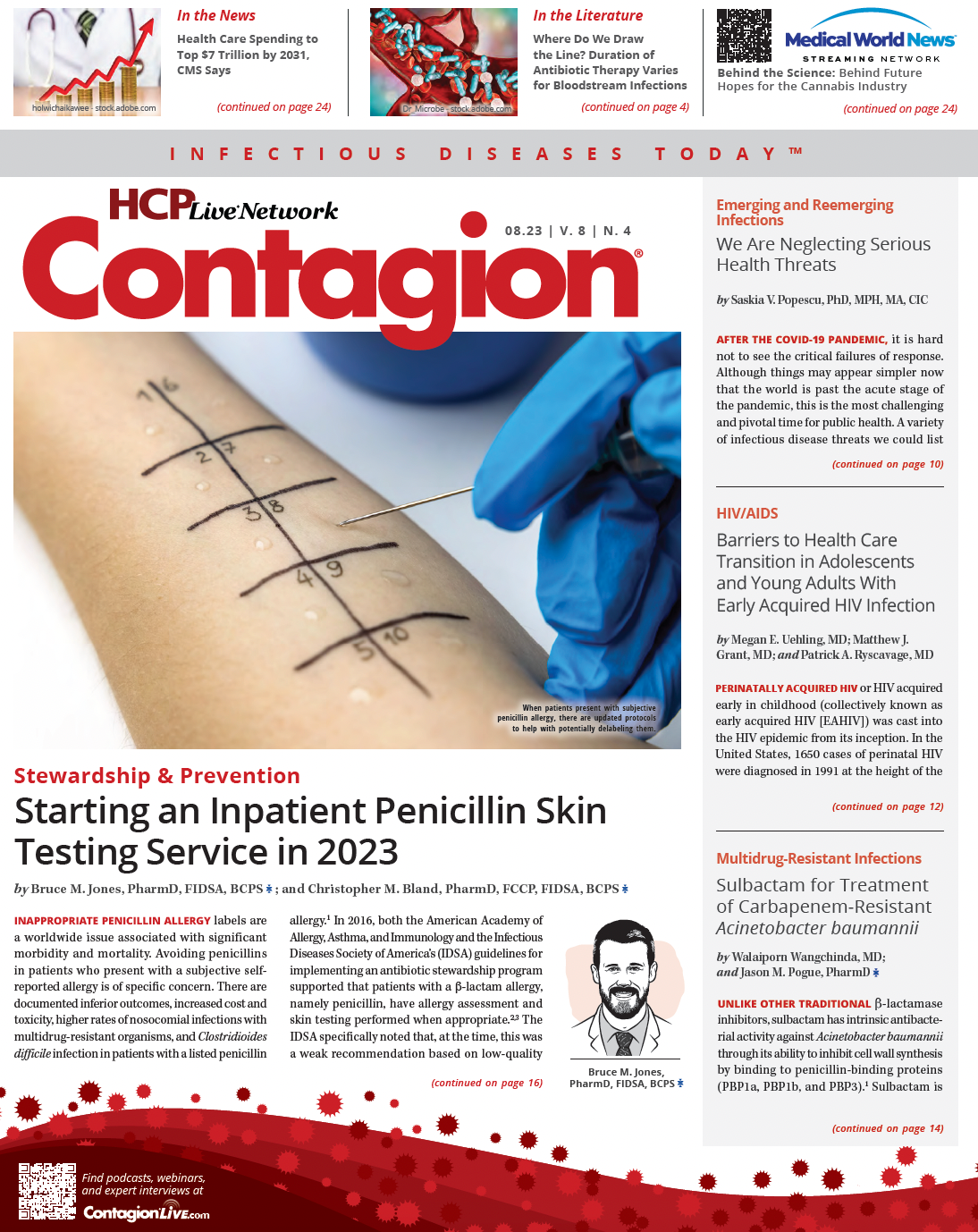Starting an Inpatient Penicillin Skin Testing Service in 2023
Patients with a penicillin allergy can be safely delabeled using minimal resources, opening up treatment options.
Inappropriate penicillin allergy labels are a worldwide issue associated with significant morbidity and mortality. Avoiding penicillins in patients who present with a subjective self-reported allergy is of specific concern. There are documented inferior outcomes, increased cost and toxicity, higher rates of nosocomial infections with multidrug-resistant organisms, and Clostridioides difficile infection in patients with a listed penicillin allergy.1 In 2016, both the American Academy of Allergy, Asthma, and Immunology and the Infectious Diseases Society of America’s (IDSA) guidelines for implementing an antibiotic stewardship program supported that patients with a b-lactam allergy, namely penicillin, have allergy assessment and skin testing performed when appropriate.2,3 The IDSA specifically noted that, at the time, this was a weak recommendation based on low-quality evidence, as many of these publications were not associated with direct changes as part of a comprehensive antimicrobial stewardship effort.3 Significant progress has occurred, demonstrating the benefit of penicillin allergy assessment and skin testing since publication of these guidelines 7 years ago.
We have previously implemented penicillin skin testing (PST) in our facility in 2014 as part of our antimicrobial stewardship program. Through this program, we were able to see a reduction in broad-spectrum antimicrobials, namely carbapenems, while showing an economic benefit, with average direct antimicrobial cost savings between $314 and $353 per patient.4,5 A recent economic evaluation study using decision models compared allergy testing vs no testing in patients who have a penicillin allergy. All models with sequential skin testing showed cost savings, with an average of $657 and $2746 for inpatients and outpatients, respectively.6 Through our experience over the past decade and with increasing additions to the literature, we recommend considerations for a facility to implement PST for clinical and economic benefits, as well as some of the barriers that might be encountered.
WHO WILL BE SKIN TESTED?
For patients who present with a subjective penicillin allergy, there is a stepwise process that should begin with a comprehensive evaluation and detailed patient interview to determine whether the patient is appropriate for intervention. Although there are no validated questionnaires uniformly accepted, there are tool kits and point-of-care references available to help clinicians decide risk stratification.1,7 Patients should be stratified as low, medium, or high risk, based on characteristics and symptoms of the reaction, how it was managed, and time since reported reaction obtained from the patient interview.1,8 Once a patient has been stratified, corresponding interventions such as rechallenge, graded challenge, PST, or desensitization can be considered. PEN-FAST specifically is a free tool for clinical decision support to identify low-risk penicillin allergies that would not require PST.7 Another recently published example focuses on acute care settings to identify low-risk penicillin allergies that might be appropriate for direct oral penicillin challenge. Patients who were designated with a high-risk penicillin allergy were referred upon discharge to an outpatient allergy clinic for PST.9 Vast improvement in knowledge regarding cross-reactivity involving side chains between various penicillins and cephalosporins has allowed significantly more administration of b-lactams. Graded challenges are also a fairly low-resource option for moderate penicillin allergies.10

Although most patients with a penicillin allergy can be delabeled safely using minimal resources, PST remains an important intervention tool. PST should be considered in a patient who is classified as moderate to severe risk with a confirmed history of immunoglobulin E–mediated reaction or an unknown history that is deemed severe risk.11 As this process can be time-consuming, we recommend an approach that gives you more bang for your buck in determining who is best for testing in an acute inpatient setting (TABLE). Most published data on cost savings associated with PST focus on antimicrobial changes after a negative test. At our facility, approximately 70% of patients who are skin tested have immediate changes to their antimicrobial regimen, with most being started on a b-lactam.5
BARRIERS TO PST AND POSSIBLE SOLUTIONS
Some of the biggest initial barriers to implementation is determining which model works best for the individual institution and having someone to guide the facility through the process and set up training and support. If your hospital or health system has an allergist on staff, this would be an ideal place to start. Many allergists are already performing skin testing on outpatients and have the training and knowledge to facilitate testing on inpatients, whether that be through them or training others within the health system (eg, nurses, pharmacists). A list of important questions to consider when starting a PST program can be found in the Table.
Another barrier to implementation is training of personnel. If your hospital does not have access to an allergist, other options for training must be sought. Initially, this was performed by implementation specialists from ALK-Abelló, who markets and distributes the branded penicillin major determinant product. In August 2023, this is expected to change to AllerQuest, who had previously manufactured the product and now will directly distribute it.12 An email communication with AllerQuest states 2 allergists on staff will set up training and support programs specifically for hospitals interested in implementation, but there is still not a clear picture of how this will be accomplished and how quickly interested institutions can have practitioners trained. Previous certificate programs through the University of South Carolina for penicillin allergy assessment and skin testing were put on hold due to the COVID-19 pandemic but are currently being updated with plans for relaunch in late 2023 or early 2024, which may allow for more training of interested parties.
For those practicing outside the United States, in resource-limited settings, or without availability of allergists, there are free resources available online that provide evidence-based strategies for delabeling penicillin allergies. These resources do not offer direct training on how to implement a PST program, but they do offer guidance on how to perform a proper evaluation and implement practice-changing interventions.13 Future initiatives should focus on providing training to these settings to further implement PST.
When allergists are not available, a goal should be to empower infectious diseases physicians and/or pharmacists to take a leading role in penicillin allergy delabeling. If pharmacists are being considered for performing PST, individual state laws must be considered. We have previously published a 2019 list of inquiries to state boards of pharmacy about pharmacists performing PST and would encourage pharmacists to contact their individual state boards for any potential updates.14
DELABELING AND RELABELING
Although most testing of patients in the acute setting is focused on immediate changes to therapy, it can be argued that delabeling and prevention of relabeling of a penicillin allergy is the long-term goal. Significant time and effort go into the delabeling process, especially when providing PST services. Therefore, ensuring the penicillin allergy is removed/clarified permanently is critical to promote long-term b-lactam prescribing in patients who are readmitted. Direct patient education and written documentation are paramount to this process. Effort must be made to ensure primary care providers, pharmacies, and dentists all update outpatient records, as well. We recently published long-term outcomes regarding prescribing of b-lactams in patients with a penicillin allergy removed by skin testing. Over an average course of 18 months after a negative test, b-lactam prescribing and overall days of b-lactam therapy significantly increased in patients readmitted receiving antibiotic therapy compared with those same patients prior to PST.15
CONCLUSION
Based on available resources, PST can be considered in most facilities as an antimicrobial stewardship initiative in patients with moderate to severe penicillin allergies to safely use b-lactams where they would be considered the drug of choice. Opportunities for certification and training outside of allergists are currently in transition, presenting an obstacle to broad-based PST implementation for antimicrobial stewardship programs, especially in resource-limited settings.
References
- Shenoy ES, Macy E, Rowe T, Blumenthal KG. Evaluation and management of penicillin allergy: a review. JAMA. 2019;321(2):188-199. doi:10.1001/jama.2018.19283
- Penicillin allergy testing should be performed routinely in patients with self-reported penicillin allergy. American Academy of Allergy, Asthma, and Immunology. July 106. Accessed June 27, 2023. https://www.aaaai.org/Aaaai/media/MediaLibrary/PDF%20Documents/Practice%20and%20Parameters/Penicillian-Allergy-Testing-Febraury-17.pdf
- Barlam TF, Cosgrove SE, Abbo LM, et al. Implementing an antibiotic stewardship program: guidelines by the Infectious Diseases Society of America and the Society for Healthcare Epidemiology of America. Clin Infect Dis. 2016;62(10): e51-e77. doi:10.1093/cid/ciw118
- Jones BM, Bland CM. Penicillin skin testing as an antimicrobial stewardship initiative. Am J Health Syst Pharm. 2017;74(4):232-237. doi:10.2146/ajhp160233
- Jones BM, Avramovski N, Concepcion AM, Crosby J, Bland CM. Clinical and economic outcomes of penicillin skin testing as an antimicrobial stewardship initiative in a community health system. Open Forum Infect Dis. 2019;6(4):ofz109. doi:10.1093/ofid/ofz109
- Sousa-Pinto B, Blumenthal KG, Macy E, et al.Penicillin allergy testing is cost-saving: an economic evaluation study. Clin Infect Dis. 2021;72(6):924-938. doi:10.1093/cid/ciaa194
- Trubiano JA, Vogrin S, Chua KY, et al.Development and validation of a penicillin allergy clinical decision rule. JAMA Intern Med. 2020;180(5):745-752. doi:10.1001/jamainternmed.2020.0403
- Staicu ML, Vyles D, Shenoy ES, et al. Penicillin allergy delabeling: a multidisciplinary opportunity. J Allergy Clin Immunol Pract. 2020;8(9):2858-2868.e16. doi:10.1016/j.jaip.2020.04.059
- Chua KYL, Vogrin S, Bury S, et al. The penicillin allergy delabeling program: a multicenter whole-of-hospital health services intervention and comparative effectiveness study. Clin Infect Dis. 2021;73(3):487-496. doi:10.1093/cid/ciaa653
- Collins CD, Scheidel C, Anam K, et al. Impact of an antibiotic side-chain-based cross-reactivity chart combined with enhanced allergy assessment processes for surgical prophylaxis antimicrobials in patients with b-lactam allergies. Clin Infect Dis. 2021;72(8):1404-1412. doi:10.1093/cid/ciaa232
- Blumenthal KG, Peter JG, Trubiano JA, Phillips EJ. Antibiotic allergy. Lancet. 2019;393(10167):183-198. doi:10.1016/S0140-6736(18)32218-9
- PRE-PEN update. AllerQuest. Accessed June 27, 2023. https://www.allerquest.com/pre-pen-update
- Staicu ML, Jeffres MN, Jones BM, Stover KR, Wagner JL, Bland CM. Penicillin-allergy delabelling resources for clinicians practicing in resource-limited settings: a full educational resource review of the grey literature. JAC Antimicrob Resist. 2023;5(2):dlad014. doi:10.1093/jacamr/dlad014
- Bland CM, Bookstaver PB, Griffith NC, et al. A practical guide for pharmacists to successfully implement penicillin allergy skin testing. Am J Health Syst Pharm. 2019;76(3):136-147. doi:10.1093/ajhp/zxy043
- Bland CM, Heil E, Asbell A, Smith SE, Jones BM. Delabeling for the duration? b-lactam prescribing in hospitalized patients after penicillin skin testing. J Allergy Clin Immunol Pract. 2023;S2213-2198(23)00663-3. doi:10.1016/j.jaip.2023.06.019

